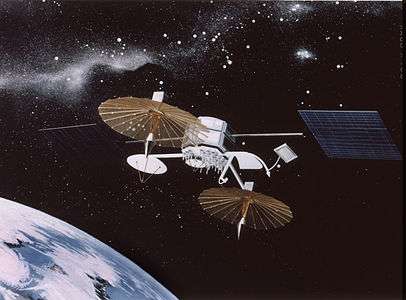TDRS-11
 TDRS-K before launch | |
| Mission type | Communications |
|---|---|
| Operator | NASA |
| COSPAR ID | 2013-004A |
| SATCAT № | 39070 |
| Mission duration | 15 years |
| Spacecraft properties | |
| Bus | BSS-601HP |
| Manufacturer | Boeing |
| Launch mass | 3,454 kilograms (7,615 lb)[1] |
| Start of mission | |
| Launch date | 31 January 2013, 01:48:00 UTC[2] |
| Rocket | Atlas V 401 AV-036 |
| Launch site | Cape Canaveral SLC-41 |
| Contractor | United Launch Alliance |
| Orbital parameters | |
| Reference system | Geocentric |
| Regime | Geosynchronous orbit |
| Perigee | 35,755 kilometers (22,217 mi)[3] |
| Apogee | 35,826 kilometers (22,261 mi)[3] |
| Inclination | 6.39 degrees[3] |
| Period | 1436.00 minutes[3] |
| Epoch | 20 January 2015, 13:09:06 UTC[3] |
TDRS-11, known before launch as TDRS-K, is an American communications satellite which is operated by NASA as part of the Tracking and Data Relay Satellite System. The eleventh Tracking and Data Relay Satellite is the first third-generation spacecraft.[4]
TDRS-11 was constructed by Boeing, and is based on the BSS-601HP satellite bus. Fully fuelled, it has a mass of 3,454 kilograms (7,615 lb), and is expected to operate for 15 years.[1] It carries two steerable antennae capable of providing S, Ku and Ka band communications for other spacecraft, plus an array of additional S-band transponders to allow communications at a lower data rate with greater numbers of spacecraft.[4]
TDRS-11 was launched at 01:48 UTC on 31 January 2013, at the beginning of a 40-minute launch window. United Launch Alliance performed the launch using an Atlas V carrier rocket, tail number AV-036, flying in the 401 configuration.[5] Liftoff occurred from Space Launch Complex 41 at the Cape Canaveral Air Force Station, and the rocket placed its payload into a geostationary transfer orbit.
Following its arrival in geosynchronous orbit, the satellite underwent on-orbit testing. It was handed over to NASA in August 2013, receiving its operational designation TDRS-11. After its arrival on-station at 171 degrees west the satellite began its final phase of testing prior to entry into service at the end of November.[6]
References
- 1 2 Krebs, Gunter. "TDRS K, L, M". Gunter's Space Page. Retrieved 31 January 2013.
- ↑ McDowell, Jonathan. "Launch Log". Jonathan's Space Page. Retrieved 31 October 2013.
- 1 2 3 4 5 "TDRS 11 Satellite details 2013-004A NORAD 39070". N2YO. 20 January 2015. Retrieved 25 January 2015.
- 1 2 "TDRS-K Media Kit" (PDF). NASA. Retrieved 31 January 2013.
- ↑ "TDRS-K Atlas V Mission Overview" (PDF). United Launch Alliance. Retrieved 31 January 2013.
- ↑ "Updates on the Tracking and Data Relay Satellite (TDRS) Fleet". NASA. 22 October 2013. Archived from the original on 20 January 2013. Retrieved 20 January 2013.
